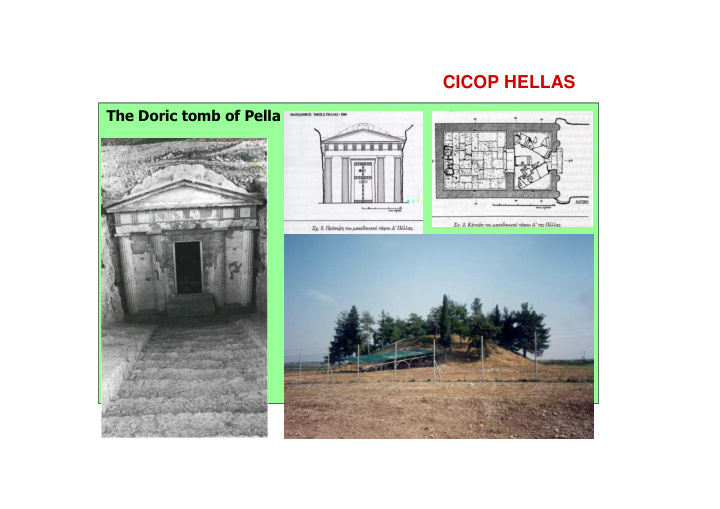



CICOP HELLAS �����������������������
ARISTOTELE UNIVERSITY OF THESSALONIKI Prof. Dimitrios Bikas UNIVERSITY OF FLORENCE Prof. Nina Avramidou, CICOP-Italy NOMINATION SUMMARY Significance of the site: Two Macedonian tombs are proposed for the Watch-List, Macedonian tomb C and D, in the area of Pella. The two tombs are representative of the type of a Macedonian tomb, because the have a temple-like front façade (the false façade is characteristic of most Macedonian tombs), one of them decorated according to the Ionic rhythm and the other according to the Doric rhythm. They both have an inside space of two chambers and vaulted roof. Additionally, the two tombs are not ruined, so they can be studied as ancient constructions buried under the earth-covering of the tumulus.
CICOP HELLAS NOMINATION SUMMARY Urgency of the threats. After the excavation, rapid changes in temperature and humidity take place inside the tombs. The air exchanges cause variations of temperature and relative humidity. During the years these processes cause deterioration to the monments, as : exfoliations of the wall surface decorations, salt efflorescences, biological and mechanical damages, cracks on the rock because of frost. All this deterioration does not happen in a short time, but as the years pass and -if no protection actions are made- they create a background for future loss of the tombs. We have to consider that the building material - a local porous limestone- is not a very strong material and the load of the tumulus covering the tombs is very high. Additionally, the luck of appropriate management in the surrounding area expose the tombs to human vandalism.
CICOP HELLAS NOMINATION SUMMARY Viability of proposed actions. I : Stabilization of the two tumuli and consolidation of the cracks and exfoliations of the wall surface's plasters must be done immediately. II : Documentation and Hydrothermal performance assessment (duration one year). Monitoring of the hydrothermal conditions inside the tombs, is very important to assess the deterioration processes. III : Future Management Plan for the tomb (microclimate) and the surrounding area (accessibility, visitation). Protection against future deterioration can only be assured through a sustainable management, based on environmental aspects and taking into account specific assessment criteria.
Recommend
More recommend